This is a Minolta X-570 35mm Single Lens Reflex camera which first went on sale in April, 1983. It was called the X-500 in Europe in Asia. The X-500 was available in both chrome and black, but the X-570 was black only. The X-570 was considered to be a “step down” camera to Minolta’s top of the line X-700, even though it offered several improvements to the viewfinder over the X-700. It was one of the last manual focus SLRs released by Minolta before they released the auto focus Maxxum series. It was not a huge hit when it first came out as it was seen as a lower level camera to the X-700, but in the years since has become favored by photographers and collectors for its fully capable feature set, small size, excellent ergonomics, and excellent viewfinder.
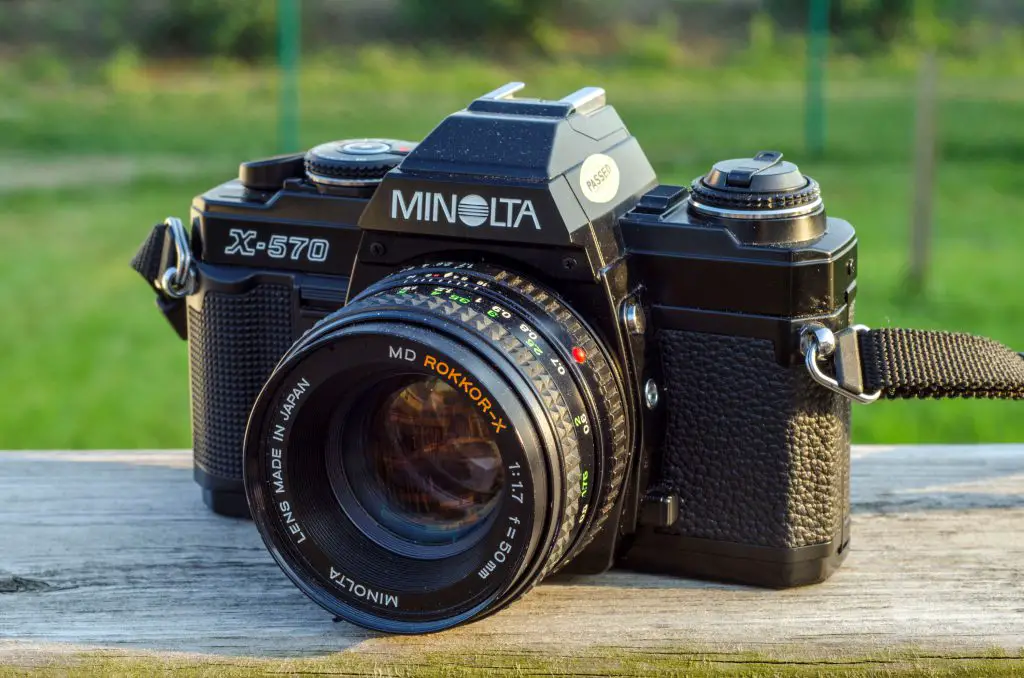 Film Type: 135 (35mm)
Film Type: 135 (35mm)
Lens Mount: Minolta Bayonet MC/MD Mount
Lenses: 50mm f/1.7 Minolta Rokkor-X PF coated 6-elements
Focus: Fixed SLR Prism
Shutter: Focal Plane Cloth
Speeds: B, 4 – 1/1000 seconds
Exposure Meter: Silicon Photo Cell TTL Meter with Aperture Priority Auto Exposure
Battery: 2 x S76/LR44/SR44/357 1.5v Alkaline, Silver-Oxide, or Lithium Cells
Flash Mount: Hot Shoe, plus PC X-Flash Sync
Weight: 803 grams (w/ lens), 486 grams (body only)
Manual: http://www.cameramanuals.org/minolta_pdf/minolta_x-570.pdf
My Final WordHow these ratings work |
The Minolta X-570 is one of the best manual focus SLRs Minolta ever made. It is light weight, yet solidly built, it has a full information viewfinder that is as large and bright as viewfinders in modern DSLRs today, it supports full manual mode along with aperture priority auto exposure mode, and can use it’s meter in full manual mode unlike many other SLRs of the past 30 years (Hello Nikon N80!) It is a good looking camera, especially in black, that has excellent ergonomics and is a pleasure to hold and shoot with. Getting one in good working condition could be difficult due to a common capacitor problem, it’s worth trying to find one in good condition, especially if you have a collection of Minolta MC/MD mount lenses. This is my favorite Minolta camera I’ve ever held or used, and one that I hope to use many times in the future. Simply, this is one of the best manual focus cameras made by any manufacturer, ever. | ||||||
| Images | Handling | Features | Viewfinder | Feel & Beauty | History | Age | |
| 2 | 2 | 2 | 2 | 1 | 0 | 0% | |
| Bonus | +1 for overall greatness, one of the last and best of the manual focus era | ||||||
| Final Score | 10.0 | ||||||
History
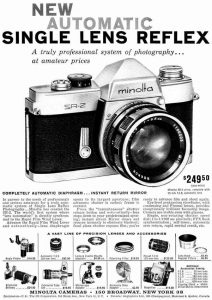
Minolta would release it’s first SLR, the SR-2 in 1958 (why wasn’t it called the SR-1, or simply the SR…I have no idea!). Although behind several other Japanese camera makers like Asahi, Miranda, and Topcon to the SLR party, Minolta did beat both Canon and Nippon Kogaku (Nikon) by one year. Unlike Canon and Nikon however, the SR-2 was not a high end camera aimed at the professional market. The SR-2 was a rather rudimentary SLR which lacked interchangeble viewfinders, the ability to re-open the lens aperture after each shot, any sort of depth of field preview, or any type of exposure metering system. It did however have a self timer, a rapid return mirror, and introduced the world to the SR lens mount, which would be the basis for the company’s later MC and MD mount lenses.
Minolta would quickly release the SR-1 and SR-3 in 1960 which improved upon many of the SR-2s shortcomings, and the SR-7 in 1962 which has the distinction of being the worlds first SLR with a built in CdS exposure meter. Although the meter on the CdS was not through the lens, this was still a pretty big achievement considering most light meters of the day were still selenium cell based.
The SR-7 was pretty advanced for it’s time and was in production until 1967, outselling many other Japanese SLRs along the way. Unlike other metered cameras of the day which relied on a LVS or light value scale which required the photographer to get a measurement from the meter and then translate that into both shutter speed or aperture readings to get proper exposure, the meter on the SR-7 was coupled to the shutter speed dial. The meter would correspond properly to whatever shutter speed the camera was set to, and the photographer would simply have to select whatever aperture the meter was pointing to. It’s worth mentioning that this system predated the “match needle” system that’s visible inside of the viewfinder. The only meter readout was a display on the top plate of the camera.
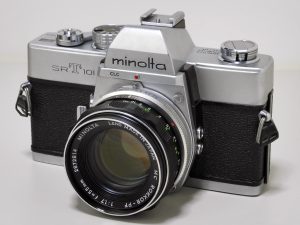
Despite these somewhat primitive features, the SR series was considered to be innovative at the time and sold very well. By 1966, the expectations of a modern camera had rapidly changed, so Minolta would release the SR-T series. The “T” meant through the lens (TTL) metering. Although Minolta was not the first company to release an SLR with TTL metering, it was the first to do it with open aperture metering. This meant that the photographer was free to compose and focus their image with the lens at it’s widest aperture while still allowing the meter to register a proper light reading. Upon firing the shutter, the camera would stop down the lens an instant before opening the shutter, to properly expose the image at whatever aperture value was selected on the lens. This was groundbreaking stuff for 1966 and allowed the first model in the series, the SR-T 101 to be one of Minolta’s most successful models ever. It was in production from 1966 – 1975 and although I couldn’t find anything about production numbers, judging by the huge amount of them for sale on eBay at any given moment, my guess is millions had to have been made.
The entire SR-T series was hugely successful with many different revisions and submodels made between 1966 and 1981. I won’t go over every model, but if you really want to know more about the whole series, I highly recommend spending some time at The Rokkor Files website which goes into pretty good detail about most of Minolta’s SLR cameras.
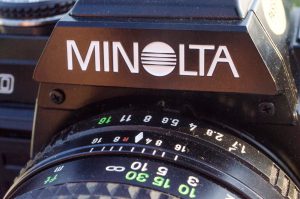
By the early 1980s, the landscape of the camera world had changed. SLRs were no longer considered to be for professionals only. There were many consumer oriented models aimed at novice photographers. Almost every major camera maker had fully automatic CPU controlled “Program Mode” cameras, and the market was seeing an increase in cheap point and shoot cameras as well. The expectations of what should be included in an SLR camera were pretty high. While autofocus SLRs were still a few years away, consumers expected high spec, fully loaded models that could be shot in full manual, full auto, or anywhere in between. To meet this demand, in 1981 Minolta would release their top of the line X-700.
The X-700 was a state of the art camera with an enormous array of accessories and features. It was awarded the European Camera of the Year award in 1981 and was so popular that it remained in production for nearly 18 years. The model could be purchased new as recently as 1999. The X-700 could shoot in shutter priority, aperture priority, or full program mode. It allowed for interchangeable focus screens, a depth of field preview button, a completely electronic shutter capable of stepless speeds from 4 seconds to 1/1000 seconds, and a shutter blind for long exposures.
Despite the wide array of features, it curiously was missing a feature that many photographers had come to expect in the early 80s, which was a full information viewfinder. A full information viewfinder shows both the selected aperture and shutter speeds in the viewfinder in manual mode. While the advanced auto exposure modes were certainly attractive to beginning photographers, the more advanced photographer who might buy an X-700 thought this to be a pretty significant omission to the X-700’s feature set.

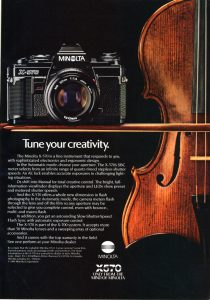
This would be corrected in Minolta’s next model, the X-570, which is being reviewed here. Released in April 1983, the X-570 (X-500 in Europe and Asia) was considered to be a “step down” model in Minolta’s line up. It lost full program and shutter priority modes and manual +/- exposure adjustment, but still could shoot in aperture priority or full manual modes, and it had a viewfinder that would show both aperture and shutter speed in the viewfinder.
The X-570 had a feature that wasn’t really advertised as much of a feature back then, which was the ability to display both selected and measured shutter speeds in the viewfinder. This means that the photographer could simultaneously see a metered reading in the viewfinder and adjust their selected speed by choosing something different, all without having to lower the camera from your eye. This may seem like an inconsequential feature, but it’s quite handy when shooting in manual modes. Many competing SLRs would simply deactivate the meter when shooting in manual mode.
Another improvement to the X-570 compared to the X-700 was the ability to have flash sync at speeds below 1/60th of a second. This means a photographer could still use a flash with slower shutter speeds to help enhance night time, or low light photography. The X-700’s flash sync is limited to 1/60 only.
The X-570 had a few other minor changes simply due to advancements of the electronics between the X-700’s release in 1981 and the X-570 in 1983. I won’t go into all of them, but once again, the review of the X-570 at the Rokkor Files does an outstanding job of explaining all of the differences. Simply put, even though the X-570 was positioned as a lesser model in the lineup and lost the X-700’s signature “Program Mode”, it gained a few features that actually made it a better camera. As a result, in the decades after the X-700 and X-570 were released, the X-570 has become somewhat of a preferred model to the X-700.
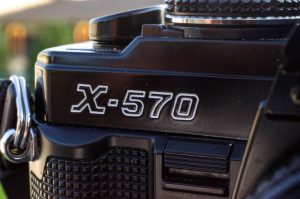
Today, both the X-700 and X-570 are considered the best of Minolta’s manual focus lineup. While Minolta would continue to have success in the SLR market and would be the first company to release a fully autofocus SLR, these two models are still very desirable today and as such can fetch high prices on the used market. One potentially fatal flaw of both cameras however, is that both suffer from a common electronics problem with capacitors inside of the camera. Sadly, the electronics of the 1980s simply were not designed to withstand 3+ decades of use and many examples today have bad capacitors which render the camera useless. There are a couple of articles online showing how to replace these capacitors, but it requires not only the ability to open up the camera, but you need to be adept at soldering as well.
My Thoughts
I’ve experienced my fair share of SLRs that have been made over the years. From the earliest Exaktas, to an all electronic Nikon N80, I’ve at least once held pretty much every make out there. I’m a self professed Nikon fan, but have always kept an open mind about other makes and models. If I had to pick a number 2 favorite brand, I find myself drawn to Yashica, but in terms of a modern SLR, Yashica pretty much didn’t exist in the modern era, so my next favorite would be Minolta. I’ve owned more Minolta bodies and lenses than any other maker (except Nikon), yet my most modern Minolta SLR was the excellent and very underrated XG-7 (I had an XD-11 once, but sold it because it had issues). With that XG-7, I had accumulated quite an array of Minolta MC/MD mount lenses, and wanted to see what their later models were like.
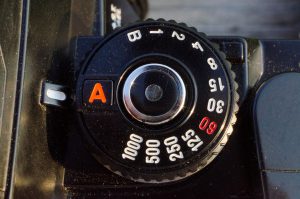
There are quite a few people on the Facebook Vintage Camera Collector’s group who herald the X-700 and X-570s as two of the best manual focus cameras ever. One comment that comes up often with these is how bright and easy to use the viewfinder is. This is especially important for me as I have such poor vision and often struggle with the darker viewfinders in SLRs from the 60s and 70s.
The big downside to getting either an X-570 or X-700 is the issue with the capacitors going out. Apparently this is something that can affect greater than half of the available ones out there. Sadly, the issues with electronics on cameras from the late 70s and 80s is becoming more and more of an issue. It’s not limited to just Minolta. The otherwise excellent Canon T90 is also known for having problems with it’s electronics rendering it useless today.

With that in mind, I knew that if I were to ever try out an X-700 or X-570, the cost would have to be low as I knew I wasn’t willing to attempt a solder repair on an electronic camera. Between the two models, the X-570 was more interesting to me, but I didn’t care which one I got. As luck would have it, an X-570 showed up on eBay for a very attractive price. The seller did not do himself any favors by including an image of the shutter halfway engaged. When you see a focal plane shutter with the perforation halfway through it’s travel, this is almost always a sign that the shutter is bad. The seller promised the camera worked properly. I even contacted the seller regarding this picture and asked why the shutter is half engaged, and he said that he doesn’t know why that happened and that he assured me it was working. Considering eBay’s buyer friendly policy of giving out refunds if an item is not as promised, I put out a low bid, and I won.
I knew I was playing with fire. I bought a camera known to commonly have electronics failures, with a picture showing the shutter inexplicably halfway engaged. Upon it’s arrival, I was ecstatic to discover that the camera was in good working order, and that one shot of the shutter halfway engaged was simply an example of very poor timing. I really think that the seller really lost out on higher bids with that picture. What’s so strange is that even after I brought it to his attention, he never updated the auction to remove that picture. His loss, my gain, I guess!
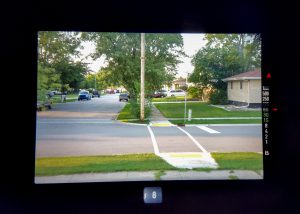
I put two fresh batteries into the camera and replaced the light seals and found the camera to be as easy to use as promised. I loved the viewfinder and compare this camera’s feature set very favorably to the Canon AV1. I can wholeheartedly agree with the comments from other members declaring that the viewfinder on this camera is as bright and as easy to use as described. Comparing the viewfinder to that of a much more recent Nikon N80, or even the one in my D7000 DSLR, the one in the X-570 is nearly identical in terms of brightness and size. The aperture value is just a simple window showing what’s selected on the lens barrel, and the shutter speed is displayed via red LEDs on the right side of the frame so it doesn’t compare from an information standpoint, but if you want a large and bright optical viewfinder in a manual focus camera, it doesn’t get much better than this.
Edit 3/13/2017: After having this camera for a while, I’ve taken it out on a couple of occasions to shoot more film. I found that even when off, the camera drains the batteries after about 2 months. I am on my third set of Energizer Silver-Oxide 357 batteries. I am not sure if this is a symptom of my particular camera, or if they were all like this, but nevertheless, it might be a good idea to make sure you remove the batteries from your X-570 when storing it.
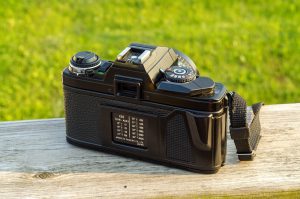
The X-570 came out at a time when manufacturers were already using lightweight plastics to keep the weight of the camera down, but not at the expense of a quality build. The X-570 feels solid and well built in your hands. The plastic doesn’t creak, and all of the dials and the wind lever have no flex or wiggle to them. The front and rear of the camera have an early version of the large hand grips which would become common in cameras in the mid 80s and beyond. Although small compared to modern cameras, these protrusions are well designed to enhance your grip on the camera. Simply, the build quality of the X-570 is excellent and by no means reflective of it’s stands as a “mid priced” camera.

The controls and layout of the camera are all in logical places and exactly where you’d expect to find them, with the only exception being the power switch. This is simply a nitpick, but since this is such a great camera, I really have to think hard to come up with something to complain about. As a Nikon fan, I prefer Nikon’s method of “powering” on the camera by pulling back on the wind lever a bit. I’ve read that some people don’t like Nikon’s method as it potentially causes the wind lever to interfere with some people’s faces while shooting, but I like it. I find it so much more natural to give the wind lever a slight “bump” into the “on” position, and then push it back when done shooting to power off the camera. Minolta uses a much more traditional On/Off switch to the left of the viewfinder. I find it’s location to feel a bit like an afterthought and something you could easily forget to disable after shooting. It’s worth mentioning that the shutter release on the Minolta has a capacitance touch feature that will only power the meter on when your finger makes contact with the switch. In theory, the camera’s power switch could remain in the ‘On’ position and still not drain the battery, but I have not found any conclusive evidence online confirming this.
The power switch has a third position that enables audible warnings for slow speeds and the self timer. You can use this mode to warn you if the meter has selected a speed slower than 1/60, or to beep while the self timer is counting down.
Beyond the power switch, I really have nothing else to complain about. The Minolta X-570 is indeed a very fine camera. It came out at a time when the design of the manual focus SLR had pretty much been perfected. It supports all of the manual features you could ever want, including a depth of field preview, aperture priority auto exposure, a self timer, and a full information viewfinder. It has excellent ergonomics, is relatively light weight, and one of the largest and brightest viewfinders of the era.
My Results
Normally when shooting a camera that’s new to me for the first time, I try to stay away from expired film, but this time I didn’t follow my own rule, and instead shot a roll of Kodak Zoom 800 film with an unknown expiration date (probably the 1990s). Assuming it was 2 decades expired, I set the ASA film speed dial on the camera to 200 to add two stops of overexposure to the film.
The majority of the roll was shot at my uncle’s house for his birthday. The shots were all taken in the evening on a sunny day, but entirely in shade. I used Aperture Priority mode at f/8 for the first 5 images below. The last 3 shots were done in an abandoned farm house near my work. I also had the camera in AE mode, but I believe I opened the lens up to f/2.8 or possibly even f/1.7, I cannot remember.
My track record of shooting expired 35mm film hasn’t been so good with other cameras. The problem with expired film is that the results can be unpredictable because you never know how well the film was preserved. Had it been in a freezer for 20 years, it’s likely the film could have performed nearly identical to when it was new. Film that sat in a closet, or worse, in a hot attic or garage will degrade much more, rendering muted colors, excessive graininess, or other anomalies. Furthermore, 800 film by it’s very nature is more grainy than slower films like 100 and 200, so take a film that was grainy to start with, and add ~20 years of unknown condition and you never know what you’re going to get.
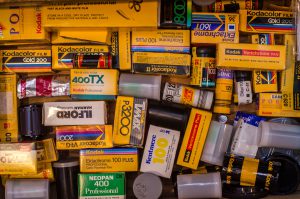
Thankfully, the film held up pretty well, and setting the ASA dial to 200 was a wise choice as all of the shots seem to have come out properly exposed. Had I shot this as an actual 800 speed film, I predict everything would have been dark and murky.
Part of me wishes I had used fresh film for this first roll as these shots would have been more vibrant, but I also think that the expired 800 film suited this camera well because of it’s extremely accurate meter and capable lens. Had I tried to use this roll in an older, less capable model, I might have had much worse looking results. Still, what I have here is impressive. I can only imagine what the X-570 could do with a fresh roll of Ektar or color slide film.
If it’s not obvious by now that I thoroughly enjoyed using this camera, I’ll say it here. The Minolta X-570 is one of the best cameras made by any manufacturer ever. I am ecstatic that I was able to find one in working condition and cannot wait to shoot with this camera again. If you have an opportunity to pick up one of these in working order, do it. Even if you find one that has the capacitor issue, I urge you to find someone who can fix it.
Related Posts You Might Enjoy
External Links
http://www.rokkorfiles.com/X-570.htm
http://www.fogdog-photography.com/fogdog-blog/2018/11/19/minolta-x-570
https://photographychronicles.wordpress.com/2012/08/13/the-minolta-x-500-aka-x-570-review/
http://camera-wiki.org/wiki/Minolta_X570
http://www.juergen-adler.de/2015/02/14/minolta-x-500-die-h%C3%BCbsche-kleine-schwester/ (in German)

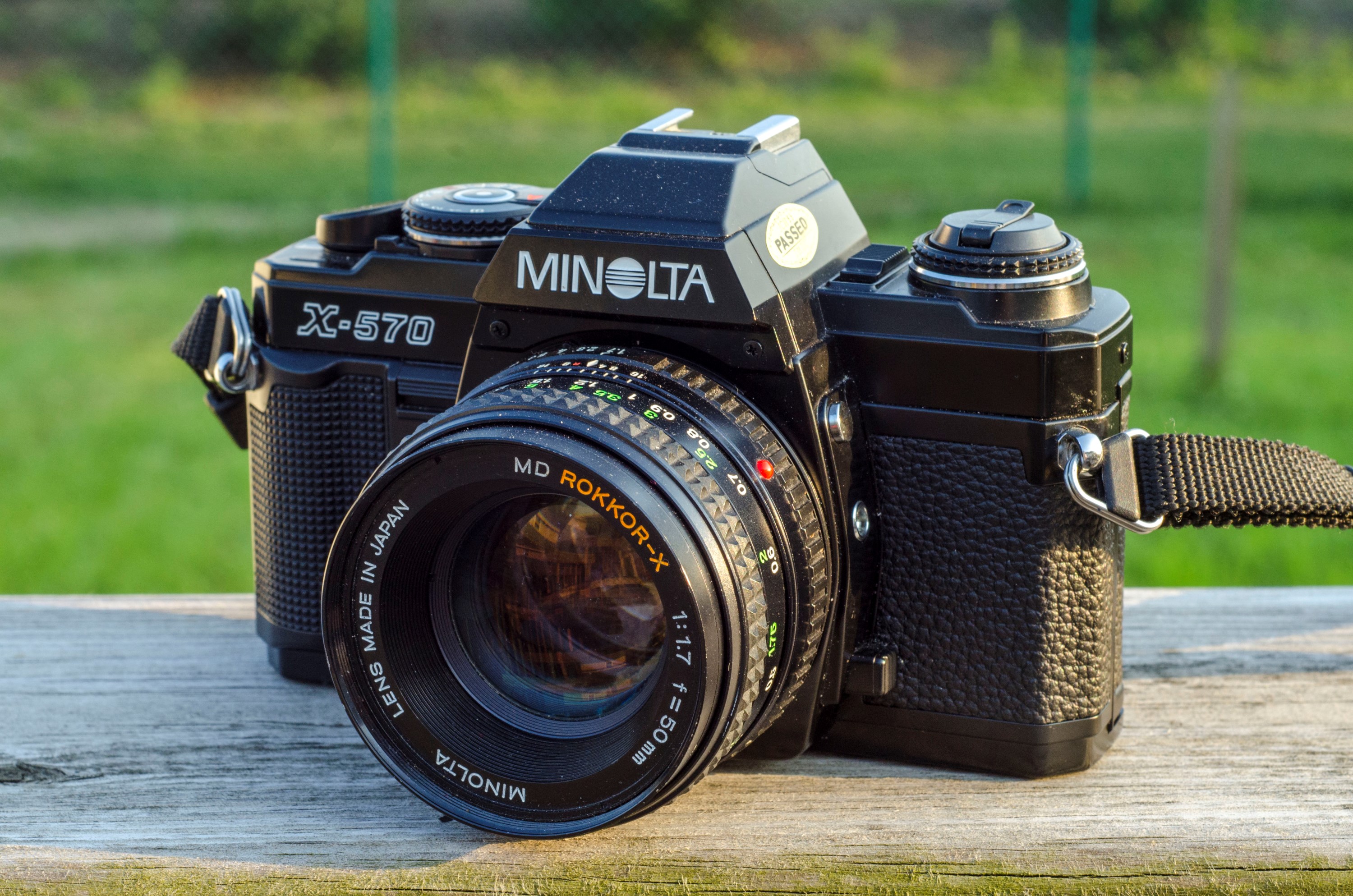
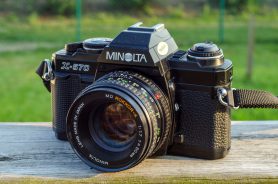








Excellent write up of a camera that is such a close relative to my first “real” camera that I got in 1989, the X-700 you make a number of references to. I can see that the 570 is a very capable camera, and almost wish I’d gone with with a model like this over the 700, as I tended to rely on the Program mode a bit too much with the 700.
When I was considering models though, I never saw the 570 as an available option in 1989 – the step down model by this point was the silver-clad X-370 that seems by nearly all accounts to be similar if not identical to this X-570 in feature set. A friend of mine had a 370 and it performed just fine for him.
From personal recollection, I’d toss the X-700 in a bookbag (gasp!) for years, and likely left the power switch on to be able to use it quickly if needed, and the silver oxide cells would typically work for a year or two between changes. 🙂
I just wanted to add my two cents about the X-570 for what ever it’s worth. I love Minolta cameras and have since my first XE-7. The X-570 in my opinion is the the third best Minolta made (XE-7 #1, XD11 #2). I have a few in my collection and love them. I know the capacitor issue well on these 80’s cameras but I have never had the issues any of my 570’s. Now the 700’s is a different story, but they are relatively easy to fix. The battery drain issue on yours is definitely an issue. My battery life is typically a year or two depending on usage.
Anyways Mike, I want to thank you for your reviews. As a camera collector myself, I like reading others opinions of cameras that I own, or want to own. I really like your reviews and I look forward to reading more.
Thanks for the kind words, Anthony! Do you have any advice on how to improve the battery drain issue? It has never improved since I’ve owned my X570, and it’s part of the reason the camera doesn’t get used more often, despite making excellent photos!
Mike, from what I know and understand, it could be a short in the wiring, failing or faulty capacitors, dirty contacts, or a combination of of these. If I had to guess, I would say the caps and dirty contacts around the speed selector and the capacitive shutter button. Now this is just a guess. I would probably start by removing the top cover and cleaning the contacts then remove the bottom cover and check the wiring.
I do agree with you on the photo quality. I think the Rokkor glass is world class.
I bought a X500 on ebay and within a month the dead lights and shutter told me that the capacitor was u/s fortunately on the x570 there is only one capacitor to worry about and it is easily got at under the bottom cover. I am no electronics genius and i am as ham fisted as the next man but it was relatively easy to swap the old cap for an equivalent tantalum one which makes a permanent fix as this will never burn out.
A full information viewfinder shows both the selected aperture and shutter speeds in the viewfinder in manual mode, but who needs it? The advanced amateur does not, because he/she can rapidly reach any available setting in an AE mode on the 700, while retaining ‘last moment’ auto metering control. Manual mode on the X-700 is intended for use with separate metering, which takes the eye from the viewfinder, so viewfinder info is not required.
The X-700’s flash sync is limited to 1/60 only? Not so. A slip of insulating tape (that every advanced amateur carries) in the hot shoe sorts that in ten seconds. Not that it is likely to be a good solution on the 570; having to keep a button depressed while shooting at 1/30th or slower is a recipe for wasted film! A flash meter, or a decent flash that has variable manual mode, is likely to serve far better in high contrast conditions, anyway.
Minolta knew exactly what they were doing with the professional’s X-700. The 500/570 was a cynical bit of marketing, using spare electronic capacity for useless gizmos. Minolta would have done far better to provide a decent exposure-adjustment dial instead, but that would have cost money.
My childhood was quite literally captured by a Minolta X-570. I grew up in the late 80’s and early 90’s, and my family has photo albums filled to the brim with pictures taken by my Mom’s X-570. I never thought much about the camera as a kid. It was just “Mom’s camera,” sort of ubiquitous and always there. Looking back at those old prints, however, there is a certain soul to them that modern digital pictures just don’t seem to have.
We recently broke out the old Minolta, which likely hasn’t been used in 15+ years. I expressed an interest in using it to take some pictures. Lo and behold, when I put new batteries in the camera it was DOA. A little searching online led me to this and other websites where I learned about the supposedly dreaded capacitor issue.
I would like to say this so others are aware: DON’T FEAR THE CAPACITOR! It’s an easy fix! One only needs to remove four little screws to take the bottom plate off, and then the capacitor is right there, very easily accessible. I happen to be handy with a soldering iron, but I have very unsteady hands. Yet I was still able to replace it without a problem.
The result? The camera works perfectly! Now I just need to get some film and start shooting.
Here are some links that helped me out immensely regarding the capacitor:
https://www.paulbeesley.com/posts/2017/12/minolta-capacitor-replacement
[youtube=https://www.youtube.com/watch?v=-0XjHPRLzhk&w=640&h=360]
Great feedback Dave, and glad you got your mom’s old camera up and running! I’ve personally never dealt with a dead capacitor, but now I kinda want to! 🙂
Minor correction: Minolta X-570 uses silicon photocells in its metering system, not CdS cells.
You’re right! I fixed it and updated the article! 🙂